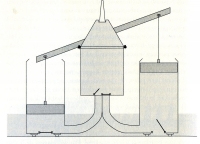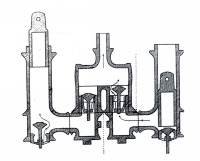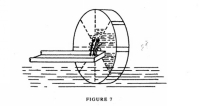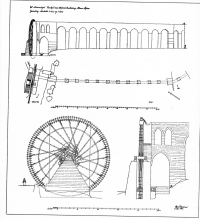Recommended literature
- Vitruvius: De Architectura
- J.G. Landels: Engineering in the Ancient World (1978 / 2000)
- J.P. Oleson: Greek and Roman mechanical water-lifting devices: the history of technology (1984)
- J.O. Oleson: Water-lifting (in: O. Wikander (ed): Handbook of Ancient Water Technology (2000) pag 217 - 285)
- A.I. Wilson: Machines in Greek and Roman Technology / Water-lifting devices (in: J.P. Oleson (ed): The Oxford handbook of engineering and technology in the classical world (2008) pag 350 - 355)
Shaduf
One of the oldest known tools used to raise water from a well, river or lake is the shaduf. This simple mechanism, used since pharaonic and classical times, consists of a bucket attached to a rope at the long end of a wooden pole. The pole rests on a fulcrum with a counterweight at the short end of the pole. When an operator pulls down the long end of the pole, he lowers the bucket into the source, and the counterweight hauls the full pail back up to the surface.Shadufs were introduced in Spain in the sixth century of our era, but not until the 14th century did they spread north to Germany. They also were adopted in Flanders (in present-day Belgium), where the 16th-century artist Pieter Bruegel the Elder depicted them in engravings of Flemish farms. Although they have largely disappeared from northern Europe, shadufs remain widespread throughout the Middle East, notably along the Nile.
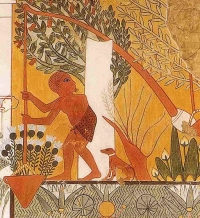
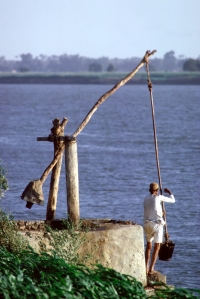
Cerd
Animal power has been used for centuries to lift water from wells. The cerd, also called a mot, sanya or sanija, was developed in India. The device consists of a self-emptying animal skin bag connected to a rope and guided by a simple pulley. A harnessed animal, usually an ox or camel, is used to raise the filled bag to the surface where it empties itself into a trough or canal. The animal is typically rewarded with food or water at the end of each lift. Depending on the water supply and the number of available animals, a cerd could irrigate areas up to several acres in size. The cerd was a considerable achievement in irrigation as it shifted the toil from man to beast.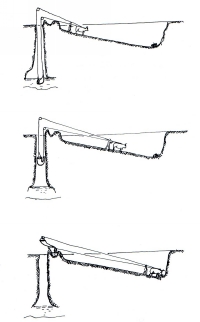
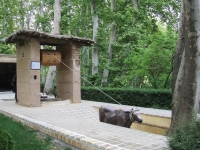
Cormpartmented wheel / Tympanum / Noria
Tympanum
Probably the oldest type of water-raising waterwheel was known as the tympanum to the Romans, and tympanon or tympanion to the Greeks (i.e., "drum" or "tambourine"). Although this type of waterwheel could lift a large volume of water, it could raise it less than half the diameter of the wheel.Consisting of a hollow wooden framework enclosed in a skin of planks like a drum, the interior was usually divided into eight wedge-shaped compartments, the walls of which were sealed with pitch or wax to prevent leaks. The wheel rotated in the vertical plane and was mounted on a heavy horizontal axle. The heavy construction of this type of waterwheel meant that it had to be powered by men(normally low-grade slaves or condemned criminals) treading on its perimeter, or by beasts of burden harnessed to right-angled gearing (known as a saqiya gear in Arabic). As successive compartments were immersed in the water at the wheel's base, they were filled through equidistant slots in the wheel's rim. When each compartment reached the horizontal level of the axle, the water emptied into a trough through a circular hole located in the axle of the wheel at the terminus of the compartment's side walls.
See also: Vitruvius X.4.1-2
Noria
Rotated by water-power, noria waterwheels, such as the Albolafia in Córdoba, turned first in Iran, where al-Muqaddasi described numerous norias along the Ahwaz River around the year 1000. Later, the noria became a mainstay of irrigation throughout al-Andalus. Still today in Syria, the city of Hama's 20-meter-diameter (64') wheel, equipped with 120 compartments that empty into a stone aqueduct, lingers as a nostalgic landmark alongside the Orontes River. Writing in 1154, the geographer al-Idrisi marveled over an Andalusian noria twice that size that lifted water from the Tagus River to Talavera de la Reina near Toledo. There are two types: with a compartmented rim, or a rim with small containers (wooded buckets or pots).See also: Vitruvius X.4.3
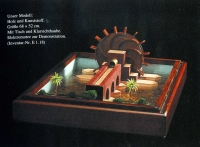
|
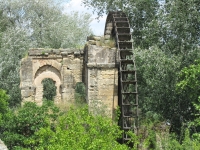 |
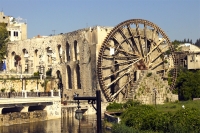 |
Saqiya gear + Bucket chain / Pot garland
Originating in Persia around the same time as the qanat (7th c BC), the saqiya is an animal-powered mechanism of interlocking wooden gears, usually two, set at right angles to each other. A donkey or mule is harnessed to a pole fixed to the broad, horizontal wheel, which is set with posts generally less than a meter tall-the teeth of that gear. These posts mesh at right angles with thick pins set into a vertical waterwheel, the second gear. Attached around the circumference of the vertical wheel are clay pots. When the animal walks in a circle, rotating the horizontal wheel, it rotates the vertical wheel, which dips the pots into the water one by one. As each pot reaches the top of its arc, its water pours into a wooden sluice. According to historian Ibn Bassal, the saqiya was the most widely used method of irrigation in the Muslim world by the 11th century.See also: Vitruvius X.4.4
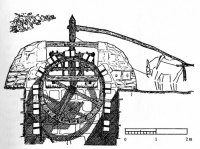
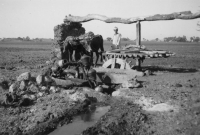
Archimedes screw
This classical device, named for the third-century BC Greek mathematician who first documented it, is composed of a wooden screw mounted inside an inclined cylinder. As the screw is turned, the spiral thread lifts the water into a sluice. Writing around 20 bc, the Greek historian Strabo described just such an Archimedes screw raising water from the Nile.See also: Vitruvius X.6.1-4
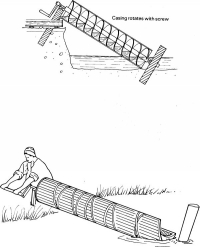

Force pump
"The force pump is unique among the ancient water-lifting devices for both its technically more complex design and its characteristic squirting delivery. The force pump usually sits in the water and it is intended to lift and pushes it up a discharge tube by means of pistons working in a pair of cylinders. Literary sources clearly link the force pump with Philo and Ctesibius in Hellenistic Alexandria. At least 25 Roman examples have survived in bronze, lead, and wood.The early imperial examples found at Bolsena and Castrum Novum provide clear, typical examples of the design as executed in bronze. Two cylinders mounted vertically, side by side, are connected near their bases by a horizontal pipe of more or less the same diameter; there are hinged, bronze flap valves at the bottom of each cylinder, opening inward. A bronze piston - possibly originally fitted at its base with leather or fleece gaskets - working within each cylinder allowed water to enter and fill the cylinder through the flap valve on the up stroke, then drove it into the transverse connecting pipe on the down stroke, which closed the intake valve. A single upright delivery pipe rose from the centre of the connecting pipe, and one-way flap valves at the base of this pipe kept the water moving in the proper direction as the pistons worked reciprocally.
One of the Bolsena pumps actually had very modern looking beveled spindle valves instead of flap valves. Depending on the application, the water might be discharged from a pipe, or through a nozzle. Such a nozzle has been preserved only on a large bronze pump found in a Roman mine at Sotiel Coronada. A type of "universal joint" made by fitting pipes into each other to allow turning meant that the nozzle could easily be pointed in any direction".
From: J.P. Oleson: Water-Lifting - Force Pumps (in: O. Wikander (ed): Handbook of Ancient Water Technology (2000) pag 272-4)
See also: Vitruvius X.7.1,4
